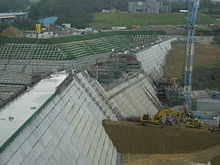- Okukubi Dam
-
Okukubi Dam 
Downstream face of the dam in July 2011Official name 億首ダム Country Japan Location Kin, Okinawa Coordinates 26°27′54″N 127°55′54″E / 26.465°N 127.93167°ECoordinates: 26°27′54″N 127°55′54″E / 26.465°N 127.93167°E Status Under construction Construction began 2009 Opening date 2012 Construction cost ¥3 billion ($38.2 million USD) Owner(s) Development and Construction Department, Okinawa General Bureau Dam and spillways Height 39 m (128 ft) Length 462 m (1,516 ft) Volume 339,000 m3 (443,395 cu yd) Crest elevation 29 m (95 ft) Impounds Okukubi River Type of spillway Labyrinth weir Spillway capacity 430 m3/s (15,185 cu ft/s) Reservoir Capacity 8,560,000 m3 (6,940 acre·ft) Active capacity 7,860,000 m3 (6,372 acre·ft) Catchment area 14.6 km2 (6 sq mi) Surface area 0.61 km2 (0 sq mi)[1] The Okukubi Dam (億首ダム) is a trapezoidal cemented, sand and gravel (CSG) dam, under construction on the Okukubi River in Kin, Okinawa Prefecture, Japan. Construction began in 2009 and it is expected to be complete in 2012.[2] It is the first trapezoidal CSG-type to be constructed as a main dam in the world.[3][4] Its purpose is to provide flood control and water for municipal use along with the irrigation of 70 ha (173 acres) of land.[5]
Contents
Background
Construction on the dam had originally begun in 1978. At that time, it was designed as a concrete gravity dam. Construction was halted soon after it began though.[6] The dam was redesigned over the next few decades and after the new project was approved, preliminary construction for the dam began in late 2003. Principal construction began on March 24, 2009 and there was a groundbreaking ceremony on June 5, 2009.[7] To divert the river, a cofferdam did not need to be constructed. The existing Kinmu Dam 100 m (328 ft) upstream was modified to divert the river on the left bank of the river.[8][9] In May 2010, the river was diverted and by August of the same year, over 1,042,000 m3 (1,362,885 cu yd) of rock and stone had been excavated from the site.[10] On February 26, 2011, a ceremony was held to bury the cornerstone of the dam prior to beginning the fill of the dam's body. It was attended by Japanese and U.S. officials (due to the dam's location within the U.S. Marine Central Training Area).[11] It will cost ¥3 billion (US$38.2 million) and it is expected to be completed in March 2012.[12][7]
Design
The dam is a 39 m-tall (128 ft) and 462 m (1,516 ft) long trapezoidal CSG-type with a structural volume of 339,000 m3 (443,395 cu yd). The cemented, sand and gravel (CSG) design is a mixture of a concrete gravity dam and an embankment dam. Essentially, it is a sand and gravel embankment coated in concrete. This design is cheaper because it uses less fill and concrete when compared to a gravity or embankment dam. Its wide base provides the required strength while the concrete coating seals the embankment and adds to its durability.[3] The dam's crest lies at an elevation of 29 m (95 ft) and sits at the head of a 14.6 km2 (6 sq mi) catchment. The dam's main spillway will be a labyrinth weir-type over its main crest. It will have a design discharge capacity of 430 m3/s (15,185 cu ft/s). The dam will be equipped with an emergency spillway as well, which will have a capacity of 160 m3/s (5,650 cu ft/s).[13] It will impound a reservoir with a capacity of 8,560,000 m3 (6,940 acre·ft), of which 7,860,000 m3 (6,372 acre·ft) is active (or "useful") capacity. The reservoir's surface area will be 0.61 km2 (0.24 sq mi).[14]
References
- ^ "Okukubi Dam Overview" (in Japanese). TAISEI Corporation. http://www.okukubi-dam.com/gaiyo.html. Retrieved 24 July 2011.
- ^ "Construction progress" (in Japanese). TAISEI Corporation. http://www.okukubi-dam.com/kotei.html. Retrieved 24 July 2011.
- ^ a b "Okukubi Dam is the world's first trapezoidal CSG dam". North Dam Construction Office. http://www.dc.ogb.go.jp/hokudamu/e/okukubidam.html. Retrieved 24 July 2011.
- ^ (Organised by Spanish National Committee on Large Dams -SPANCOLD), Edited by L. Berga (2003). Roller compacted concrete dams : proceedings of the IV International Symposium on Roller Compacted Concrete (RCC) Dams, 17-19 November 2003, Madrid, Spain. Rotterdam [u.a.]: Balkema. pp. 27. ISBN 9058095649. http://books.google.com/books?id=a5ph53CsiUsC&pg=PA27&dq=okukubi+dam&hl=en&ei=ixAsToaULY2JmQXLpvm5Dw&sa=X&oi=book_result&ct=result&resnum=1&ved=0CCsQ6AEwAA#v=onepage&q=okukubi%20dam&f=false.
- ^ "Purpose". North Dam Construction Office. http://www.dc.ogb.go.jp/hokudamu/jigyou/kakudamu/okukubi/mokuteki/index.html. Retrieved 24 July 2011.
- ^ "Dams in Okinawa: Okukubi" (in Japanese). PCPulap. http://pcpulab.dip.jp/main/okukubidam.htm. Retrieved 24 July 2011.
- ^ a b "Construction progress" (in Japanese). TAISEI Corporation. http://www.okukubi-dam.com/kotei.html. Retrieved 24 July 2011.
- ^ "Schedule" (in Japanese). North Dam Construction Office. http://www.dc.ogb.go.jp/hokudamu/jigyou/kakudamu/okukubi/yotei/index.html. Retrieved 24 July 2011.
- ^ "River Diversion" (in Japanese). North Dam Construction Office. http://www.dc.ogb.go.jp/hokudamu/jigyou/kakudamu/okukubi/kansei/tenryukou/index.html. Retrieved 24 July 2011.
- ^ "Okukubi Dam" (in Japanese). CMED. http://cmed.jp/sekou2011/okukubi.html. Retrieved 24 July 2011.
- ^ Baez, Dengrier M. (4 March 2011). "Ceremony marks completion of Dam". Marines.mil. http://www.marines.mil/Pages/NewsStoriesItemDetails.aspx?ItemUrl=http%3A%2F%2Fwww.marines.mil%2Funit%2Fmcbjapan%2FPages%2F2011%2F110304-dam.aspx. Retrieved 24 July 2011.
- ^ "Managing a wild horse with a rotten rope: A contemporary history of Okinawa". The Ryukyu-Okinawa History and Culture Website. http://www.niraikanai.wwma.net/pages/wildhorse/chap3-12.html. Retrieved 24 July 2011.
- ^ "The design of the spillway of the dam neck billion (adoption of the labyrinth weir)" (in Japanese). North Dam Construction Office. http://www.dc.ogb.go.jp/hokudamu/jimusyo/katudo/happyou/img/ronbun15.5.pdf. Retrieved 24 July 2011.
- ^ "Key Features of Dams in Okinawa". North Dam Construction Office. http://www.dc.ogb.go.jp/hokudamu/e/element.html. Retrieved 24 July 2011.
External links
- Official website (Japanese)
Dams in Okinawa Prefecture Aha Dam · Arakawa Dam · Benoki Dam · Fukuji Dam · Fungawa Dam · Haneji Dam · Kanna Dam · Kinjo Dam · Kurashiki Dam · Okukubi Dam · Taiho DamCategories:- Dams in Okinawa Prefecture
- Dams under construction
Wikimedia Foundation. 2010.


